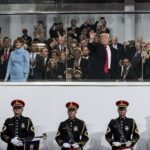No matter who you are, where you live, or what you do, your life is controlled by land. In an increasingly crowded world hungry for resources and space, the ownership of land dictates every aspect of our lives. Land determines power, wealth, and our very identity. So says Michael Albertus, a professor of political science at the University of Chicago and author of the book Land Power: Who Has It, Who Doesn’t, and How That Determines the Fate of Societies.

Albertus spent over 15 years conducting fieldwork in more than a dozen countries to better understand the central role land plays in politics and society. From China to Colombia and California to Spain, Albertus examined how the allocation of land can transform feudal agrarian societies into economic and political powerhouses just as it can spark famine and environmental catastrophe.
In his book, Albertus takes readers on a sweeping journey across time and space, from a world where Homo sapiens roamed freely on an open and abundant landscape to a crowded planet that has been settled, divided, conquered, and dominated by kingdoms and colonizers, always in the quest for power at the expense of someone else.
Land Power presents dozens of case studies exploring how the way in which land is used can make life better or worse, not only for humans but for all other life forms who live off the land, simply, naturally, without agriculture or industry, treaties or decrees.
On Feb. 10, Michael Albertus spoke with Jon Letman for Inkstick Media. Their conversation has been edited for length and clarity.
Jon Letman: In your book you write about Doñana National Park in southern Spain, a vast wetland of great ecological and biological importance where Europe and Africa intersect. You describe the struggle between forces who wanted to develop the land for agriculture and logging and those who sought to preserve it. This land, which you call “an unrivaled natural area of critical wildlife sanctuary” also had a role in the establishment of the World Wildlife Fund. Is there any place in the US that shares parallels with Doñana?
Michael Albertus: I think most analogous would be places in Alaska that remain [largely] undeveloped. Much of [this land] is owned by the federal government. Places like the Arctic National Wildlife Refuge, Denali National Park, and Wrangell-St. Elias are much more wild than the Doñana National Park, but in a similar fashion they’re critical to biodiversity [and are in] the crosshairs of climate change. What happens in those places will in many ways shape how humans relate to the land and the natural environment and what we will pass down to future generations.
You write that “land is a potent tool in the construction of racial hierarchy. Racial and ethnic groups can rise to dominate others by stealing their land and livelihoods, carving deep ruts across civilizations that endure generations. Those ruts cut straight through economies, politics, and communities.” As an example, you profile the Agua Caliente/Cahuilla people of Coachella Valley and how colonial settlers and the reallocation of Cahuilla ancestral land led to the development of Palm Springs, California. With so many examples of annexation, displacement, and resettlement of Native Americans in North America, why did you decide to focus on this one?
For me, the example of the Agua Caliente in Palm Springs is a perfect one. Like many Native American communities, though, their story is a common one. Land reshuffling in the American West for them meant land dispossession. The US government forced them into a lopsided treaty that ceded much of their land base in 1852. Twenty-five years later the federal government granted the Southern Pacific Railway a right of way in that area and, as was a common practice at the time, they granted the railway every other square mile of public land. That clearly divided the tribe and generated this checkerboard pattern of a reservation.
It’s patently ridiculous. How can you imagine a people that have an ancestral homeland relating to that land, managing that land and maintaining their cultural and spiritual connections to the land when it now looks like a checkerboard? It’s an especially cruel and effective way of breaking down tribal cohesion in the community. And it was part of creating this new racial hierarchy in the American West, dominated by white settlers in which a reservation was created through checkerboarding.
The Agua Caliente are a band of the Cahuilla nation. Within the broader Cahuilla nation there are at least four or five other reservations in that same area of Riverside County that are also checkerboarded in a similar fashion. The policy of granting public land to railroads ultimately gave more than 100 million acres of land over to railway companies.

Let’s talk about land policies under the Trump administration. In his first three weeks, he has spoken repeatedly about wanting to take control of the Panama Canal, buy Greenland, annex Canada, and take ownership of and develop Gaza. Each of these alone would be an extraordinary declaration, but together it seems the stuff of fantasy. How seriously should these proposals be taken?
These are shocking assertions of American power and interest in the acquisition of foreign territory in ways we have not seen in many decades in the United States. It is not unprecedented, but it has been quite a long time. The post-World War Two era, and particularly the Cold War era competition over influence in the developing world ushered in this unusual period of territorial stability. But the biggest drivers of land and territorial acquisition — human population growth and state-making — haven’t stopped. The global population is heading towards 10 billion before the end of the century, and at the same time we face the consequences of climate change.
I would present a pecking order of seriousness for treating these claims. I think probably Canada would be at the bottom. I don’t foresee the United States trying to acquire Canada very soon. Panama Canal is probably the second to the bottom. I would also find it rather surprising [if] the United States actually sent military troops to try and reacquire the Panama Canal. I think Greenland is quite serious and I think that Gaza is definitely not un-serious. It’s a serious claim and Trump has not backed off of either of those despite significant global and domestic pushback.
Greenland lines up with a number of different US interests that make it a bit more of a serious claim. The US has a military base there. Greenland is going to be on Arctic shipping routes that are starting to open up. There’s been about a 40% increase in Arctic shipping over the course of the last decade and that is going to continue as Arctic ice melts. So there are strategic reasons for thinking about the future of shipping routes.
It’s also clear that because Arctic ice is melting, Greenland is starting to be scouted more and more for valuable mineral resources, and it’s anticipated to hold quite substantial mineral resources, including some that could be vital for the green transition. So there are real concrete interests there.
I think it’s a serious claim [but] I don’t think we’re anywhere close. Greenland is not for sale. The people of Greenland are having an election next month. Public surveys show very little interest, but it’s not impossible to imagine an offer that could at some point in coming years be entertained.
Gaza sort of came out of nowhere. I don’t think it was an off-the-cuff remark and Trump certainly hasn’t walked it back, despite the fact that some high-level officials have tried. Trump himself has not hedged that claim at all. There has been this gradual erosion of the vision of a two-state solution and the creation of a Palestinian state. This would probably put an end to it entirely.
The proposal at its face almost seems ridiculous in that it’s proposing a war crime and a crime against humanity of a large scale — mass removal of Palestinians from their homeland. [Nearly] seventy percent of the structures in Gaza have been entirely destroyed or badly damaged. It does need to be rebuilt and so it would be a boon to Israel if this were to happen. I can’t imagine there would be a lot of popular support for it in the United States. I think that there will be unanimous opposition across the Middle East — aside from Israel — and just about worldwide.
To me, it represents a proclivity to a new American expansionism and a turn towards “might makes right.” For the most part, I wouldn’t dismiss many of these claims. I think they’re going to continually fester for the next couple of years.
Straight out of the gate the Trump administration has quickly and aggressively undertaken a well-organized campaign to cut, disrupt and dissolve federal agencies and programs. How do you think this will impact the control and use of land in the United States?
The Trump administration has made it very clear it thinks that the federal government has far too many employees and it’s trying to lay people off en masse. One consequence of this is that the federal government owns a ton of office space, some of which is vacant, and they’re going to own more vacant office space after this. Offloading a bunch of vacant commercial real estate in a sector that’s already under considerable stress might generate more problems for revenue in cities as well as property taxes on these buildings.
Another aspect is the management of federal lands. I think it would be totally unsurprising if the federal government were to start to go after agencies that are involved in the management of federal lands as part of the broader effort to deregulate the use of federal lands to open them up to resource exploitation, timber concessions, oil extraction, other mineral extraction, and the like. That is a big deal. That’s going to really impact federal land.
It’s going to impact the relationship as well between the federal government and Native American communities, many of whom have historic claims on those federal lands. I think those partnerships are going to fray or break apart and the government is going to open up these lands to a greater degree.
Some members of Trump’s cabinet who oversee land use, resource management and environmental stewardship have deep ties to the fossil fuel industry. Some have very limited environmental or political experience, and others have a history of climate denial. Trump has tasked them with reducing climate and energy regulation, imposing traumatic staff cuts, and pursuing energy dominance. How will this impact America’s wilderness, natural resources, biodiversity, and human landscapes?
I think there could be grave damage to the natural landscape and to ecologies and biodiversity under this new administration. This is something that presents a bit more continuity — the treatment of the environment and focus on the exploitation and extraction of natural resources. I will say that markets for energy have shifted pretty significantly since the last Trump administration. So while the administration is going to open these lands to greater exploitation, [that’s] not going to stop the train of green energy. Going back to entirely gas cars or giving up on EVs or solar or wind energy is not going to happen. But in general, there will be a much more permissive environment for the exploitation of federal land.
Days after becoming president, Trump issued an executive order committing to enhance America’s dominance in AI with an active search to build huge data centers. These data centers require proximity to infrastructure and large amounts of power, water, and mineral resources to fuel AI. How will developing the AI industry impact land ownership, access, and use?
AI is in some ways land-intensive in the sense that you need places for data centers, and you need to power these areas, whether it’s through solar arrays or dams or natural resource extraction. That is something that is going to connect AI and land. It also will affect the value of land. Land today underpins about 40% of the value of real estate in the United States, and that is considerably higher in places where there’s more crowding and higher demand for land.
Also, there’s spillover in this interesting relationship between tech entrepreneurs, tech billionaires and the land in the sense that not only is land a target for locating the hearts and lungs of AI and computing power, but also many of these people are investing in land.
These things are going to be enormous consumers of power and that has huge implications. If, for example, you’re thinking about hydroelectric power, where are you going to get that power from? How is it going to impact the communities that live along those rivers and the like? It involves displacement, it involves change in the natural environment, and has big implications so I’m not surprised that there’s going to be pushback in many places.
Vast amounts of water is needed to fuel AI. Meanwhile people in Sudan and Somalia, for example, are hungry for food and water and security.
The inequalities here are gross inequalities. They’re very extreme. We see that in the relationship of humans to the land in many different ways around the world. Everything from this attempt by Trump to acquire and dominate Gaza to the creation of AI centers and the very unequal access to resources, whether it be water or oil.
Cover image: Photograph by William S. Prettyman of the Land Run of the Cherokee Strip that opened settlement to the Cherokee Outlet in Oklahoma on September 16, 1893.
Hey there!
You made it to the bottom of the page! That means you must like what we do. In that case, can we ask for your help? Inkstick is changing the face of foreign policy, but we can’t do it without you. If our content is something that you’ve come to rely on, please make a tax-deductible donation today. Even $5 or $10 a month makes a huge difference. Together, we can tell the stories that need to be told.




















